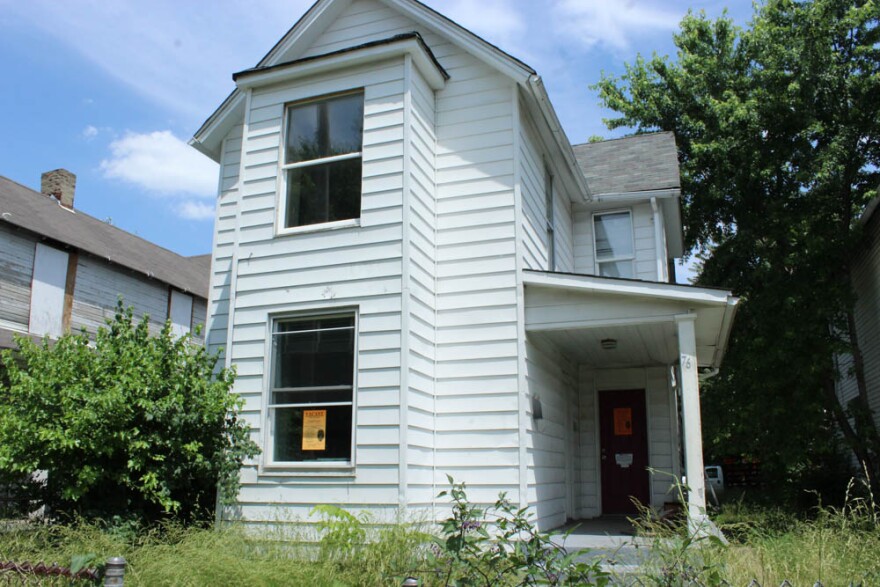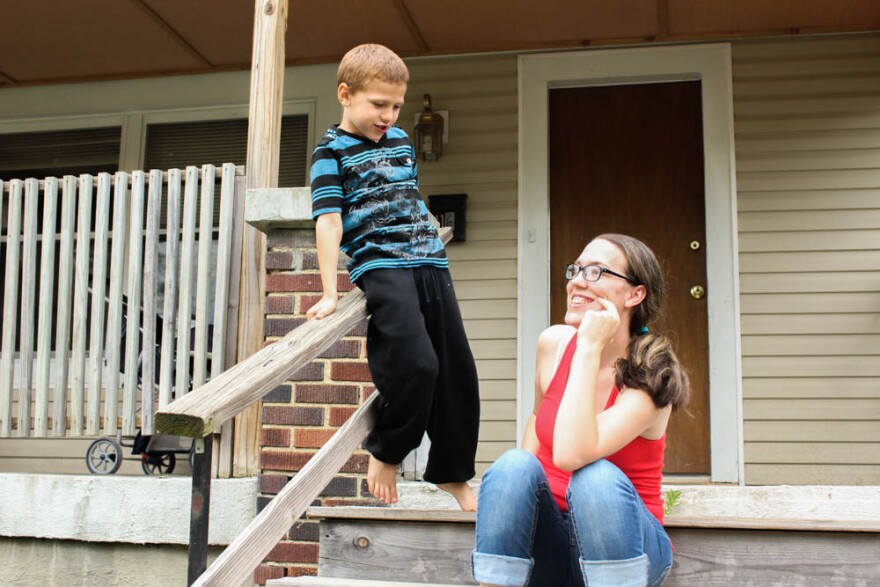Lead paint was banned from homes in 1978, but lead poisoning still affects nearly half a million children each year. Each year doctors diagnose some 600 children in Franklin County with lead poisoning. In the second part of our series on the hazard of lead paint in our homes, we look into the case of one home where children were poisoned by lead despite the efforts of the health department.
In The Hilltop neighborhood the house on 76 Rodger Avenue is white and faded. The concrete steps are cracked and the grass in the yard has grown over the chain-link fence. An orange sign posted to the front door reads “vacant public nuisance and/or hazardous building.” In late 2015 the city ordered the home be vacated. A child here was poisoned by lead paint.
After a child is found with lead poisoning the city will test for lead paint in the home. If they find a lead hazard, the owner has 90 days to fix the issue. In this case the home was a rental and the landlord never took care of it.

Across the street I ask a neighbor, Patrick Mitchell if he knew the family.
“I didn’t know them, but I knew the people before and they were sick all the time and it was the people who moved in after them that found out,” said Mitchell.
I ask Mitchell and the other neighbors on the block but nobody knows exactly what happened to this family. I search the address online and turn up the name Hallie Clapper and a phone number that’s out of service.
Finally, thanks to Facebook, I find Clapper. She’s at her new home in Linden and when I meet her she’s pulling up in a minivan to unload groceries. She says that she moved from the home on 76 Rodgers Avenue a year ago.
“Well when we first moved in, the neighborhood wasn’t the greatest, but the house was affordable,” said Clapper.
Clapper says that she and her family lived at the home for a year, starting in mid-2014. They had moved from Newark and it was a this-will-do-for-now situation.
“I have four children so there were six of us in the house and so I liked that it was a big house, I liked that I had an eat-in kitchen,” said Clapper.
She says the place wasn’t in the best shape. The paint on the wood floors was chipping and it would get all over her toddler and her newborn when they crawled around.
Related: Nearly 40 Years Later, Lead Paint Remains A Hazard In Central Ohio
Clapper finally moved out July of 2015. She says the house was falling apart and she’d had enough. Three days later, she learned her kids were sick.
“Emily and Jayce, it was a routine physical and they tested them for lead and they came up high…[..].It was the two babies when they tested them they were like whoa!” said Clapper.
Clapper says their levels were nearly twice the official level for lead poisoning. Doctors told her that this was due to long-term exposure to lead. Clapper says the health department tested her new home, it turned up clean. Then they asked her about her last address.
“They were like did you live on 76 Rodgers Avenue and I was like yes I did I lived there for a year… we just moved from there, and they were like….um…. nobody’s supposed to be living there,” said Clapper.
Health officials were aware of the problem and say they warned its residents. Reports show that in early 2015 a child there was found with high blood lead levels. Clapper says it was her nephew who had just come to live with her. At the time, she suspected lead at a previous home was to blame.
Clapper remembers a lead inspector was sent to 76 Rodgers Ave and city health officials insist they sent the positive test results to the property owner and the tenant. Although, Clapper says she never received these results.
Jose Rodriguez from Columbus Public Health says there are many complex challenges in lead poisoning cases. For example families may move frequently.
“So that complicates our ability to reach people and sometimes even to reach people in a timely manner,” said Rodriguez.
Rodriguez says that sometimes, even when a family knows about a lead hazard in their home, they may choose to stay if they cannot afford to relocate.
The person legally responsible for the lead paint hazard at 76 Rodgers Avenue is the owner. According to court records his name is Donald O’Mailla and there is no indication he has fixed the situation.
By order of the city no one is allowed to live at 76 Rodger Avenue, at least not until it’s lead safe. We were unable to locate O’Mailla for this story and the trust that manages the property declined to comment.
Hallie Clapper works in healthcare, she’s in school to become a nurse, and like a lot of people she says lead paint just wasn’t on her radar.
“I never thought about it. Lead. I mean that’s something you hear about happening a long time ago,” said Clapper.
As a mom she says it feels like she’s let her kids down, her daughter who had lead poisoning is non-verbal at age 2.
“My daughter, she just ..hasn’t made any progress...and we have no way of knowing if her situation was made worse or not…she’s about to have her third birthday and she says, mom,” said Clapper.
Lead poisoning can cause behavioral disorders and developmental delays in children. Experts say lead paint could affect a few more generations before it’s finally eliminated.



